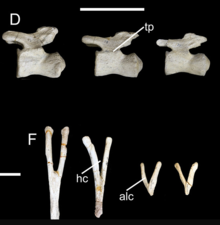Baurutitan
| Baurutitan | |
|---|---|

| |
| Caudal vertebra (D) and chevrons (F) from the holotype | |
| Scientific classification | |
| Domain: | Eukaryota |
| Kingdom: | Animalia |
| Phylum: | Chordata |
| Clade: | Dinosauria |
| Clade: | Saurischia |
| Clade: | †Sauropodomorpha |
| Clade: | †Sauropoda |
| Clade: | †Macronaria |
| Clade: | †Titanosauria |
| Clade: | †Lithostrotia |
| Genus: | †Baurutitan Kellner et al. 2005 |
| Type species | |
| Baurutitan britoi Kellner et al. 2005
| |
| Synonyms | |
| |
Baurutitan is a
Discovery
The holotype of Baurutitan were found in 1957 by
A series of 19 vertebrae (the last sacral and 18 caudals) found at this locality were recognized as belong to those of a titanosaur; they were initially named 'Series "C"', and subsequently became the holotype of the new genus Baurutitan (specimen number MCT 1490-R). All material found was stored in the collection of Museu de Ciência da Terra (Earth Science Museum – MCT) of the Departamento Nacional de Produção Mineral (National Department of Mineral Production) in Rio de Janeiro.[1]
In addition to Caieira Quarry, Price also worked in the "Point 6" or "Rodovia" site, also from the Serra da Galga Formation, about 1.5 km east of Peirópolis. Field work during the 1980s and 1990s discovered many titanosaur remains, including vertebrae and limb bones. A preliminary report found the cervical and dorsal vertebrae from the site similar to Trigonosaurus, while the caudal vertebrae were similar to Baurutitan.[2] In 2022, the remains were described, and were found to share characteristics with both Baurutitan and Trigonosaurus. This led the describing authors to synonymize the two taxa, while separating the unique paratype of Trigonosaurus as the new genus Caieiria.[3] However, not all researchers have accepted the conclusion that Trigonosaurus is a synonym of Baurutitan; John Fronimos, in 2023, did not follow the proposed synonymy due to the differencess between the first caudal vertebrae of the two taxa.[4]
Etymology
The name Baurutitan comes from the junction of the word "bauru", which alludes to the geographical region of the finding, within the
Description

Baurutitan was a
Classification
In their 2017 description of
In the 2023 description of titanosaur remains from the Serra da Galga Formation including the new taxon Caieiria, Silva Junior et al. performed a phylogenetic analysis of titanosaurs including Baurutitan (which incorporated information from Trigonosaurus). It was found to be in a clade within Aeolosaurini, which is recovered within Rinconsauria. Their cladogram is shown below:[3]
References
- ^ a b c d e Kellner, A.W.A.; Campos, D.d.A.; Trotta, M.N.F. (2005). "Description of a titanosaurid caudal series from the Bauru Group, Late Cretaceous of Brazil". Arquivos do Museu Nacional, Rio de Janeiro. 63 (3): 529–564.
- ^ Martinelli, Augustin G.; Marinho, Thiago S.; Silva, João Ismael da; Ribeiro, Luiz C. B.; Cavellani, Camila L.; Ferraz, Mara L. F.; Teixeira, Vicente P. A. (August 2014). ""Dinosaurs in the Attic": Associated titanosaur remains from the Late Cretaceous of Peirópolis (Uberaba, MG) and comments on titanosaur diversity" (PDF). Paleodest. 29 (Edição Especial: Abstract IX Simpósio Brasileiro Paleontologia de Vertebrados 2014): 81.
- ^ PMID 36405026.
- .
- PMID 28794222.
External links
- Baurutitan on the Dinosaur Mailing List Archived 2019-06-21 at the Wayback Machine
